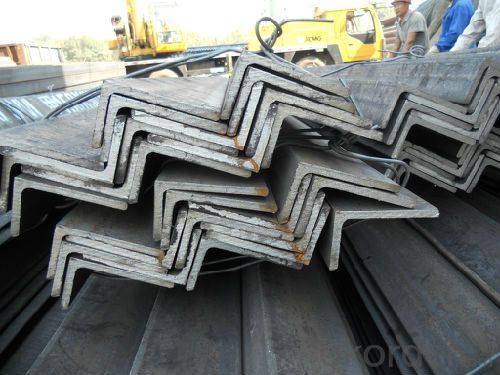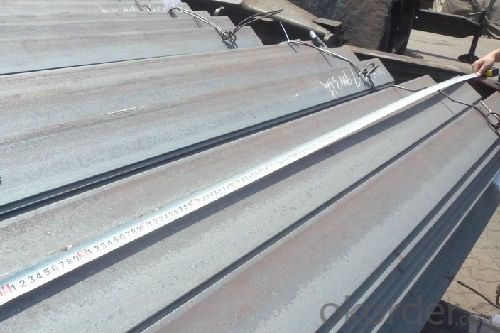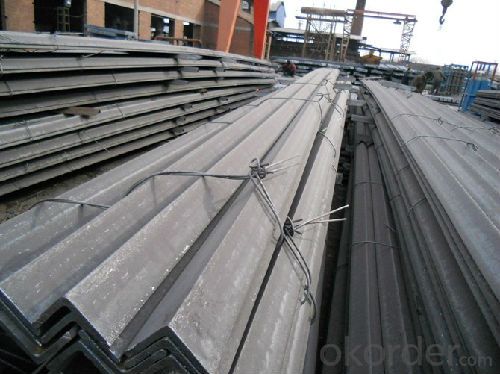Prime Low Carbon Steel Unequal Angle Bars in High Quality
- Loading Port:
- Tianjin
- Payment Terms:
- TT or LC
- Min Order Qty:
- 100 m.t.
- Supply Capability:
- 20000 m.t./month
OKorder Service Pledge
OKorder Financial Service
You Might Also Like
OKorder is offering Prime Low Carbon Steel Unequal Angle Bars in High Quality at great prices with worldwide shipping. Our supplier is a world-class manufacturer of steel, with our products utilized the world over. OKorder annually supplies products to African, South American and Asian markets. We provide quotations within 24 hours of receiving an inquiry and guarantee competitive prices.
Product Applications:
Prime Low Carbon Steel Unequal Angle Bars in High Quality are ideal for structural applications and are widely used in the construction of buildings and bridges, and the manufacturing, petrochemical, and transportation industries
Product Advantages:
OKorder's Prime Low Carbon Steel Unequal Angle Bars in High Quality are durable, strong, and wide variety of sizes.
Main Product Features:
· Premium quality
· Prompt delivery & seaworthy packing (30 days after receiving deposit)
· Can be recycled and reused
· Mill test certification
· Professional Service
· Competitive pricing
Product Specifications:
Manufacture: Hot rolled
Grade: Q195 – 235
Certificates: ISO, SGS, BV, CIQ
Length: 6m – 12m, as per customer request
Packaging: Export packing, nude packing, bundled
| UNEQUAL ANGLE STEEL | |||||
| size(mm) | a(mm) | a1(mm) | thickness(mm) | kg/m | length(m) |
| 75*50*5 | 75 | 50 | 5 | 4.808 | 6m,9m,12m |
| 75*50*6 | 75 | 50 | 6 | 5.699 | 6m,9m,12m |
| 75*50*8 | 75 | 50 | 8 | 7.431 | 6m,9m,12m |
| 100*75*7 | 100 | 75 | 7 | 9.34 | 6m,9m,12m |
| 100*75*8 | 100 | 75 | 8 | 10.6 | 6m,9m,12m |
| 100*75*9 | 100 | 75 | 9 | 11.8 | 6m,9m,12m |
| 100*75*10 | 100 | 75 | 10 | 13 | 6m,9m,12m |
| 100*75*12 | 100 | 75 | 12 | 15.4 | 6m,9m,12m |
| 125*75*7 | 125 | 75 | 7 | 10.7 | 6m,9m,12m |
| 125*75*8 | 125 | 75 | 8 | 12.2 | 6m,9m,12m |
| 125*75*9 | 125 | 75 | 9 | 13.6 | 6m,9m,12m |
| 125*75*10 | 125 | 75 | 10 | 15 | 6m,9m,12m |
| 125*75*12 | 125 | 75 | 12 | 17.8 | 6m,9m,12m |
| 150*90*8 | 150 | 90 | 8 | 14.7 | 6m,9m,12m |
| 150*90*9 | 150 | 90 | 9 | 16.4 | 6m,9m,12m |
| 150*90*10 | 150 | 90 | 10 | 18.2 | 6m,9m,12m |
| 150*90*12 | 150 | 90 | 12 | 21.6 | 6m,9m,12m |
| 200*100*10 | 200 | 100 | 10 | 23 | 6m,9m,12m |
| 200*100*12 | 200 | 100 | 12 | 27.62 | 6m,9m,12m |
| 200*100*15 | 200 | 100 | 15 | 34.04 | 6m,9m,12m |
FAQ:
Q1: Why buy Materials & Equipment from OKorder.com?
A1: All products offered byOKorder.com are carefully selected from China's most reliable manufacturing enterprises. Through its ISO certifications, OKorder.com adheres to the highest standards and a commitment to supply chain safety and customer satisfaction.
Q2: How do we guarantee the quality of our products?
A2: We have established an advanced quality management system which conducts strict quality tests at every step, from raw materials to the final product. At the same time, we provide extensive follow-up service assurances as required.
Q3: How many tons of steel products could be loaded in containers?
A3: Usually the steel products are delivered by bulk vessel because of the large quantity and the freight. However, there are no bulk vessel enter some seaports so that we have to deliver the cargo by containers. The 6m steel product can be loaded in 20FT container, but the quantity is changed according to the size, usually from 18tons to 25tons.
Images:



- Q:How do steel angles contribute to the overall energy efficiency of a building?
- Steel angles contribute to the overall energy efficiency of a building in several ways. Firstly, they can be used as structural components to provide strength and support, enabling the building to withstand external forces and reduce the risk of damage or collapse. This durability reduces the need for repairs or replacements, saving energy and resources in the long run. Additionally, steel angles can be incorporated into the construction of walls, floors, and roofs to enhance insulation and thermal performance. By minimizing heat transfer and air leakage, they help maintain a more comfortable indoor environment and reduce the reliance on heating or cooling systems, thereby improving energy efficiency.
- Q:Are steel angles resistant to pests or insects?
- Yes, steel angles are resistant to pests or insects as they are made of solid, non-organic material, which does not provide a suitable environment for pests or insects to thrive.
- Q:How are steel angles protected against abrasion?
- Steel angles are commonly used in construction and industrial applications, where they are subject to various forms of abrasion. To protect steel angles against abrasion, several methods are employed. One common method is the application of protective coatings. These coatings can be in the form of paints, epoxy coatings, or other specialized coatings designed for abrasion resistance. The coatings act as a barrier between the steel surface and the abrasive elements, preventing direct contact and reducing the wear and tear caused by friction. Another method is the use of rubber or plastic linings. These linings are typically applied to the surfaces of the steel angles that are most prone to abrasion. The rubber or plastic material absorbs the impact of abrasive forces, cushioning the steel and reducing the wear rate. Additionally, these linings provide an extra layer of protection against corrosion and chemical attacks. In some cases, steel angles may undergo a process called hardening or heat treatment. This involves subjecting the steel to high temperatures and then rapidly cooling it. This process alters the microstructure of the steel, making it harder and more resistant to abrasion. Heat-treated steel angles are commonly used in high-wear environments such as mining and material handling industries. Furthermore, engineers may opt to design steel angles with specific profiles or shapes that offer better resistance to abrasion. These profiles can include rounded edges, chamfers, or other features that minimize direct contact with abrasive materials. Overall, the protection against abrasion for steel angles involves a combination of protective coatings, linings, heat treatment, and thoughtful design. By implementing these measures, the lifespan and performance of steel angles can be significantly prolonged, reducing maintenance costs and ensuring their durability in abrasive environments.
- Q:What is the maximum thickness of a steel angle?
- The maximum thickness of a steel angle can vary depending on the specific dimensions and specifications of the angle, but it is generally available in thicknesses ranging from 1/8 inch to 1 inch or even thicker.
- Q:How do you prevent steel angles from sagging?
- To prevent steel angles from sagging, there are several measures that can be taken: 1. Proper design: Ensure that the steel angles are designed and sized correctly for the load they will bear. This involves considering the span length, the applied load, and the material strength. Consulting with a structural engineer can help determine the appropriate size and thickness of the steel angles. 2. Adequate support: Provide sufficient support for the steel angles at regular intervals along their length. This can be achieved by using intermediate supports such as columns, beams, or braces. The spacing of these supports should be determined based on the load and the properties of the steel angles. 3. Reinforcement: Depending on the load requirements, additional reinforcements can be added to the steel angles. This can include stiffeners, gussets, or flanges to increase their load-carrying capacity and resistance to sagging. 4. Quality fabrication: Ensure that the steel angles are fabricated to meet industry standards and specifications. This includes proper welding techniques, accurate cutting, and appropriate surface preparation to avoid any weak points or defects that may contribute to sagging. 5. Regular inspection and maintenance: Regularly inspect the steel angles to identify any signs of sagging or structural issues. This can involve visual inspections, measurements, and non-destructive testing methods. Promptly address any identified problems to prevent further deformation and ensure the long-term integrity of the steel angles. By following these preventive measures, steel angles can be effectively protected against sagging and maintain their structural stability over time.
- Q:What is the maximum allowable bearing stress for a steel angle?
- The maximum allowable bearing stress for a steel angle depends on various factors such as the type of steel being used, the thickness and size of the angle, and the specific application or design requirements. Generally, the maximum allowable bearing stress is determined by considering the structural strength and stability of the angle under the expected load conditions. To determine the maximum allowable bearing stress for a steel angle, it is essential to consult relevant industry standards, such as the American Institute of Steel Construction (AISC) specifications or the Eurocode design standards. These standards provide guidelines and formulas to calculate the maximum allowable bearing stress based on the angle's properties and load factors. Additionally, the maximum allowable bearing stress can also be influenced by factors such as the presence of any additional reinforcements, the presence of corrosion or surface imperfections, and the method of connection or support. Therefore, it is crucial to refer to the appropriate design codes and consult a structural engineer or professional with expertise in steel design to accurately determine the maximum allowable bearing stress for a specific steel angle in a given application.
- Q:Are steel angles available in different alloys?
- Different alloys are available for steel angles, providing a wide range of options. Typically, steel angles are made from carbon steel, which is a versatile and common type of steel. However, specific applications may call for other alloys. For instance, stainless steel angles are made from an alloy containing chromium, offering increased resistance to corrosion. In addition, high-strength low-alloy (HSLA) steel angles combine carbon steel with small amounts of elements like manganese, phosphorus, or sulfur to enhance strength and durability. This variety of alloys allows for a diverse range of applications and properties to meet specific needs across various industries.
- Q:What does "angle length" and "limb width" mean?
- The width of a limb refers to the width of the point to the edge of the angle, and the length of the limb corresponds to the length of the edge;Angle called angle, the steel strip is perpendicular to each other on both sides into the corner. There are equal angles and unequal angles. The two sides of an equal angle steel are equal in width. The specifications are expressed in millimeters of edge width * edge width * edge thickness. Such as "/ 30 x 30 x 3", that is 30 mm width equal angle, edge thickness of 3 mm.
- Q:What is the maximum length for a steel angle?
- The maximum length for a steel angle depends on various factors such as the manufacturing process, the size and thickness of the angle, and the capabilities of the steel supplier. In general, steel angles can range from a few inches to several feet in length. However, it is best to consult with a steel supplier or refer to industry standards to determine the specific maximum length for a particular steel angle.
- Q:Can steel angles be used in solar panel installations?
- Yes, steel angles can be used in solar panel installations. They provide structural support and can be used to mount solar panels on roofs or other surfaces.
1. Manufacturer Overview |
|
|---|---|
| Location | |
| Year Established | |
| Annual Output Value | |
| Main Markets | |
| Company Certifications | |
2. Manufacturer Certificates |
|
|---|---|
| a) Certification Name | |
| Range | |
| Reference | |
| Validity Period | |
3. Manufacturer Capability |
|
|---|---|
| a)Trade Capacity | |
| Nearest Port | |
| Export Percentage | |
| No.of Employees in Trade Department | |
| Language Spoken: | |
| b)Factory Information | |
| Factory Size: | |
| No. of Production Lines | |
| Contract Manufacturing | |
| Product Price Range | |
Send your message to us
Prime Low Carbon Steel Unequal Angle Bars in High Quality
- Loading Port:
- Tianjin
- Payment Terms:
- TT or LC
- Min Order Qty:
- 100 m.t.
- Supply Capability:
- 20000 m.t./month
OKorder Service Pledge
OKorder Financial Service
Similar products
New products
Hot products
Related keywords





























